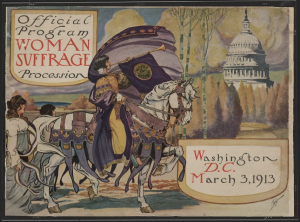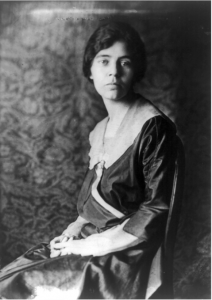
 This piece is about the Women’s Suffrage Movement. It is a poster for the procession that was occurring on March 3, 1913, in Washington, D.C. This specific poster was created by Benjamin Dale, an English composer. The poster was created as a way to promote the procession that was happening in Washington, D.C., on March 3, 1913. Through the imagery, Dale catches people’s attention with his use of color and different figures, like the horse. It was intended to inspire people to attend the process and fight for women’s right to vote. The idea was for the poster to provide people with a visual representation of what the march would be like as a form of encouragement.
This piece is about the Women’s Suffrage Movement. It is a poster for the procession that was occurring on March 3, 1913, in Washington, D.C. This specific poster was created by Benjamin Dale, an English composer. The poster was created as a way to promote the procession that was happening in Washington, D.C., on March 3, 1913. Through the imagery, Dale catches people’s attention with his use of color and different figures, like the horse. It was intended to inspire people to attend the process and fight for women’s right to vote. The idea was for the poster to provide people with a visual representation of what the march would be like as a form of encouragement.
It is important to know about the Women’s Suffrage Movement to understand this piece. The Women’s Suffrage Movement mainly focused to gaining women the right to vote in the United States. Dolton states in the article “Women’s Suffrage Movement” that the Women’s Suffrage Movement was a multifaceted campaign that sought not only the vote but also broader social and economic reforms.” This time period was essential in working to change the role that women had in society. Women like Alice Paul, Susan B. Anthony, Elizabeth Cady Stanton, Lucy Stone, etc. were crucial in the development of this movement. Bland in “New Life in an Old Movement: Alice Paul and the Great Suffrage Parade of 1913 in Washington, D.C.” focuses on Alice Paul and her influence in the specific parade that this poster is about. Bland notes how her “meticulous planning and relentless public relations ensured that the parade became a national spectacle, drawing unprecedented attention to the suffrage cause.”  Another important event during this movement was the Seneca Falls Convention in 1848, which was crucial in creating support for this movement and its cause. It is also important to know that during the procession that occurred in Washington, D.C., there were intense amounts of police negligence, and many of those who were marching were harassed verbally and physically.
Another important event during this movement was the Seneca Falls Convention in 1848, which was crucial in creating support for this movement and its cause. It is also important to know that during the procession that occurred in Washington, D.C., there were intense amounts of police negligence, and many of those who were marching were harassed verbally and physically.
This piece tells us that this time period was full of strong women who were resilient in fighting for what they believed in and for their rights. It shows how strongly gender roles were defined at the time, and how the inequality between the genders was enforced. Obviously, there were many people who opposed women fighting for their rights and independence. This is seen in Graham’s “Woodrow Wilson, Alice Paul, and the Woman Suffrage Movement” when she mentions how “Paul clashed with Woodrow Wilson, who was affronted by Paul’s ‘unladylike’ tactics, including her protests outside the White House.” Yet, despite the extreme opposition they faced, these women stood tall until they finally achieved their goal, changing the way that the United States viewed and did things moving forward.
The creator of this poster seemed to be very deliberate with every artistic choice they made. The first thing I would like to note is that is how the person riding the horse is a woman who is wearing excessive purple drapes. The use of the color purple is very significant because purple signifies royalty, power, and ambition. In using this specific color to drape the woman leading the procession, the artist is hinting at these women’s power and ambition to fight for their rights. Another thing that catches my attention is how Congress is in front of them, and they are marching towards this. The significance behind this is highly important because Congress is where constitutional amendments were made, and during this time, they were demanding that women’s right to vote be made one.
Works Cited
Bland, Sidney R. “New Life in an Old Movement: Alice Paul and the Great Suffrage Parade of 1913 in Washington, D. C.” Records of the Columbia Historical Society, Washington, D.C. 71/72 (1971): 657–78. http://www.jstor.org/stable/40067792.
CLAPP, ELIZABETH J. “The Woman Suffrage Movement, 1848–1920.” In The Practice of U.S. Women’s History: Narratives, Intersections, and Dialogues, edited by S. JAY
KLEINBERG, EILEEN BORIS, and VICKI L. RUIZ, 238–57. Rutgers University Press, 2007.
http://www.jstor.org/stable/j.ctt5hhxxp.17.
Dale, Benjamin M., -1951, Artist, and U.S. Records League Of Women Voters. Official program – Woman suffrage procession, Washington, D.C. March 3,/ Dale. Washington D.C. United States, 1913. Photograph. https://www.loc.gov/item/94507639/.
Dolton, Patricia F., and Aimee Graham. “Women’s Suffrage Movement.” Reference & User Services Quarterly 54, no. 2 (2014): 31–36. http://www.jstor.org/stable/refuseserq.54.2.31.
Graham, Sally Hunter. “Woodrow Wilson, Alice Paul, and the Woman Suffrage Movement.” Political Science Quarterly 98, no. 4 (1983): 665–79. https://doi.org/10.2307/2149723.